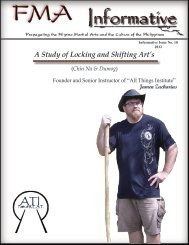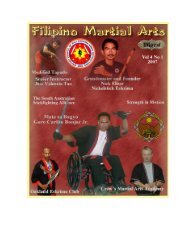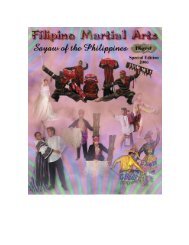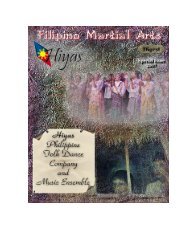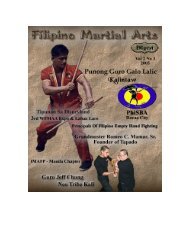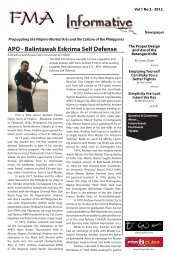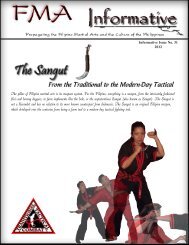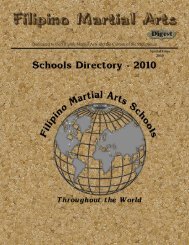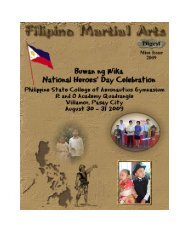Tournaments - FMA Informative
Tournaments - FMA Informative
Tournaments - FMA Informative
Create successful ePaper yourself
Turn your PDF publications into a flip-book with our unique Google optimized e-Paper software.
footwork that is often static and somewhat linear, the second half contains footwork that<br />
has an angular and circular orientation - a<br />
trend that is repeated in the advanced twoperson<br />
drills and forms. Each subset is<br />
generally repeated twice and is bracketed by<br />
what I call “bridging” subsets that occur<br />
throughout the form.<br />
Three subsets in particular are repeated<br />
every time there is a transition from one major<br />
subset to the next subset (e.g. from<br />
“Emergency” to “Bridging”) as well as in<br />
between the two repetitions of the major<br />
subsets: “Downward,” “Upward,” and<br />
“Back.” I consider these subsets to be<br />
fundamental movements and tell my students<br />
to consider that if something is repeated often<br />
enough in the Form then Momoy must have<br />
considered it important! Practicing<br />
“Downward” so many times allows students<br />
to internalize a template for movement that<br />
occurs in several variations throughout the<br />
San Miguel Form, In essence, “Downward” is<br />
the San Miguel Form - albeit a stripped down,<br />
basic, and simpler version of the form - and<br />
thus carries important lessons for the student.<br />
When students begin to learn<br />
“Downward” I have generally already taught<br />
basic strikes such as “Angle #1,” “Flywheel,”<br />
and “Media,” etc., and have shown how basic<br />
strikes can be combined to create striking<br />
patterns. For example, the striking pattern<br />
called “Uno Dos,” refers to a series of four<br />
strikes that alternate between stick strikes<br />
(“Uno”) and thrusts with the daga (“Dos”).<br />
Hence “Uno Dos” begins with a downward,<br />
diagonal forehand Redondo (or “flywheel”)<br />
with the stick (from a backhand chamber),<br />
followed by a palm-down thrust with the<br />
daga, a downward, diagonal backhand strike<br />
with the stick (Angle #2), and a palm-up<br />
thrust with the daga. “Uno Dos” can be<br />
2. The right foot is starting to pivot on the<br />
toes and the heel is rotating outwards;<br />
notice that the shoulders, waist, and hips<br />
are starting to rotate in a counter-clockwise<br />
direction.<br />
3. The heel has pivoted completely and the<br />
weight is starting to settle completely on<br />
the right foot; the shoulders, waist, and<br />
hips are starting to turn towards the front<br />
and the front foot will start to step<br />
backwards as soon as all the weight is<br />
dropped onto the right heel.<br />
4. The left foot is weightless and is starting<br />
to step back…<br />
combined with other basic striking patterns and with linear footwork to make the subset<br />
called “Downward.”<br />
It is important to understand that “Downward” begins at a point after which you<br />
have stepped forward with a palm-down strike with the daga. You take a step backward



